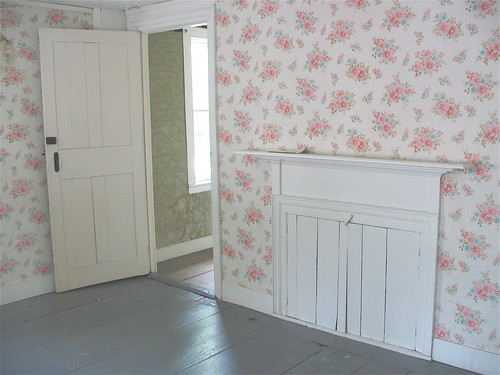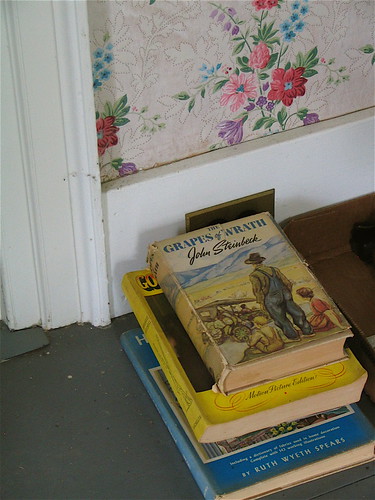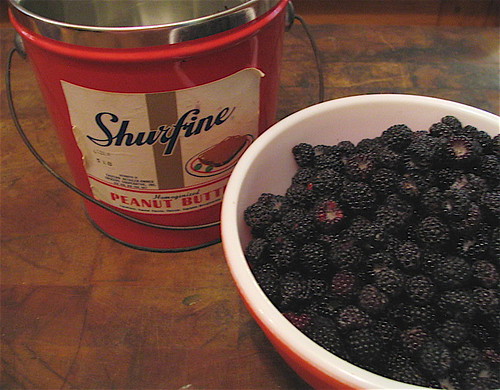Doesn't that image just bring a smile to your face and make you want to run to the refrigerator and grab a glass of ice-cold fake purple-colored, artificially grape-flavored sugar water? Well, maybe not today but it certainly used to do when I was a little girl begging my mother for some Kool-Aid™ (she'd occasionally cave to my pleas––and "PLEASE?"––in the store). I can't tell you how much I wanted a glass pitcher so I could make a smiley face on the wet perspiration. Instead, we managed with the latest Tupperware™ pitchers with the easy-open pop tops. [Even then I seemed aware that glass made everything taste better.]
I am a child of the 1960s and all of the "modern" food conveniences that were allowed. My mother, an excellent cook and like many of her friends, didn't want to spend too much time in the kitchen unless it was a special occasion or a spree of Christmas baking. Even though they were all stay-at-home-moms in that era, the emphasis was on ease and convenience and not artisanal or whole-food anything (that revival would begin, slowly, in the 1970s). That said, I remember shopping almost daily with my Mom and my brothers at Bisson's Market on West Market Street in Akron, Ohio. It was a small but fine specialty market with an emphasis on good meats and spectacular produce and within a minute by car from our house. Mr. Szabo (I may be spelling that wrong) always popped out of the back and gave us some Brach's candy from the produce section that he managed. As we weren't allowed candy in our house, except at Halloween, that was always a special treat for us. "Just one a piece," my mother would say. No wonder I craved sugar.
It was likely my parents' perseverance, as well as the fluoridated Akron water and twice yearly dental visits, that kept us cavity-free throughout our childhoods. [I was also a certified member of the post-War Baby Boomer "Clean Plate Club" but that is another study in residual childhood food issues, as well as a persistent aversion to lima beans and liver. But I don't blame my parents for turning me into a wayward Foodie--that is just a part of my DNA.]
 |
My Mom, circa 1965, in her pink 1950s suburban Akron, Ohio kitchen.
[NOTE the pink Pyrex™ bowl and her Betty Crocker cookbooks.] |
Of course, Mom bought fresh and healthy foods but I noticed an increasing reliance on new foods from the era, ones that food purists today run screaming away from with one look at their labels. Cool Whip™ soon became an essential ingredient of her simple but elegant Strawberry Cake, likely because it could withstand the Ohio summer heat and humidity when placed on the picnic table. Meanwhile, chocolate Whip-n-Chill™ (also available in vanilla and strawberry flavors) was a dessert staple. I remember when they stopped making it--was it all those chemicals and additives? All I know is that it tasted like chocolate clouds, cold and creamy and light. In Florida, my Great Aunt Fran not only made the best Key Lime Pie (with Key limes from her back yard), which I failed to appreciate at a young age, but the very best Whip-n-Chill™ pie. A few years ago I bought some chocolate Whip-n-Chill™, still made by Jello™ but sold only in Canada (like an illicit drug or something), that was distributed through Vermont Country Store (a great place to get retro anything, even when it isn't yet retro). For some reason it still sits unopened in our pantry. Am I afraid it will disappoint? Surely it will not spoil in its dried chemical vacuum-sealed state.
 |
| Yes, I have this (as yet unused) cookbook! Chemical confections for every palate! |
Later, I believe it was Jello™ that made 1-2-3™ that separated into three layers of the same color but different textures and hues when it set (who knows what lethal combustion of chemicals that required?). That was never as popular in our house but years later when I was writing
The Pantry, I learned it had been a favorite in my friend Edie's childhood (and making it in her grandparents' pantry a beloved summer memory). In the early 1970s my mother began to submit to Hamburger Helper™ and like products from Betty Crocker™. Sloppy Joes, a family favorite excepting me, were made with a powdered mix added to onions and hamburger, and heated in the electric skillet before being slopped, warm, on top of Wonder-breadish hamburger buns. Wonder Bread™! I can still see the red, yellow and blue polka dots on the white wrapper but my more esteemed culinary palate hasn't tasted it in years.
Perhaps this is one reason I became nostalgic for pantries before I could even articulate the concept: we just had a broom closet in our small 1950s post-War pink and black kitchen and my mother did not store a lot of food simply because we didn't have the room. With a market around the corner selling the latest processed food products, who needed an old-fashioned pantry? Instead, breakfast nooks were included in new kitchen designs and families ate together in the kitchen. The days of the butler, or even a waitress for an upwardly mobile middle class family, had ended with the First World War.
Going to the grocery store was a social occasion for a stay-at-home Mom on any budget. Our pink fridge, an appliance color that I did not appreciate until recently (even though I would not dare use it today), became another kind of pantry with its freezer and ice box capacity. Meanwhile, homogenized milk and dairy products arrived several times a week from a Reiter Dairy milk man in an insulated tin box on the back step (or "stoop" as we said in Ohio, certainly from the strong Midwestern Germanic influence).
 |
| Me, c. 1965, no doubt waiting for a chocolate chip cookie. |
But I loved the concept of processed food and the whole marketing pitch and packaging that went with it. I noticed these things because I studied the ads in the house and garden magazines I poured over in the living room (or even in black and white ads on television). I feared the tall, bald Mr. Clean™ in the household aisle of the grocer's as much as I thought the Jolly Green Giant™ would reach right out of the freezer case and put me into a bushel of peas. These guys were as real and looming for me as the Big Bad Wolf.
 |
| In my pink-cardboard play kitchen under the cellar stairs, along with my fake food! |
Another culinary fixture of growing up in the 1960s was the frequent use of
Betty Crocker's Picture Cookbook (I believe the 1956 edition), as well as
Betty Crocker's Cooky Cookbook of the same era. Both had been bridal shower gifts to my mother in 1961 and were the kitchen bibles and some of the only cookbooks she owned at the time. I enjoyed looking at the images of brightly colored plates and food styling, even before I could read, and eventually learned to bake and cook from those books (once I'd graduated from my aqua Easy Bake Oven™). My mother made Cottage Pudding and Golden Sauce on the rare occasion that my Grandpa came for dinner and different cookies from the "Cookie of the Year" section at the back: especially the Toll House (1946, I think?). When my parents bought a wok in the early 1970s the first thing they made was Sweet & Sour Pork--my mother labored over it all day while my father kept us away from the kitchen, knowing that we'd blanch at the thought of having to eat something so exotic (he was right).
 |
| The Pink Kitchen Strikes Again! (ad from early 1990s) |
I'm not as nostalgic for these foods for their flavor as I likely am for their associations and vivid packaging. I would not dream of buying Hostess Twinkies™ or Ho-Hos™ or Hamburger Helper™ today for my children--instead, I try to make them myself, supplementing chocolate whoopie pies or sponge cake or Tailgate Casserole (a delicious ghoulash of egg noodles, hamburger, several kinds of cheeses, and tomato sauce all layered together) for the boxed foods of the past and present. But the Pillsbury™ Dough Boy can visit my kitchen anytime, and often does, when I just don't feel like making homemade biscuits. [Come on, I'm not that much of a food snob! Even though I'm not sure what comprises the crystallized chunks of transluscent grease in their Grands™ biscuits...]

Once in a while I'll get a craving for a Fresca™[remember when they made it like Sprite in the 80s and then, thankfully, changed it back again?]. I'll pop a can open and pour it over a tall glass full of ice, take a sip, and be transported back to Akron on its grapefruited effervescence. It's a hot summer's day in the 1970s, I'm watching billowing clouds pass over our small suburban lawnscape and I hear the bubbly, happy sounds of Herb Alpert & the Tijauna Brass wafting from the hi-fi inside, perhaps from the album
Whipped Cream and Other Delights. And I'll bet that model was covered in Cool Whip™.
POSTSCRIPT July 18: I really should add that Herb Alpert and the TJB were Grand Marshalls of the Akron Soap Box Derby Parade one year in Akron––I'm guessing late 60s as I couldn't have been much older than five. My mother, who was home with my baby twin brothers, couldn't attend. My father, who was branch manager of a bank dowtown along the parade route, was able to get me, and our friends Diane and Bill, in the bank after hours to watch the parade. I'll never forget Diane, who like my mother thought Herb Alpert was the cutest thing (he was!), hanging out the second story window, in between fluted limestone columns, as the float went by. "Up here, Herb!" she yelled and waved amidst the noise of the band. He looked up at us and flashed that magic smile. I see him now, one of those indelible images from childhood memory, the float in slow motion and the colored ticker-tape and confetti raining down. A magic summer moment. But I've always been sorry that my mother missed it.




















































